What You Will Learn
(If you’re short on time, here’s the core of what this article covers, plus links to platforms giving users the freedom Character AI no longer delivers.)
- Why Character AI censorship and quality decline are pushing roleplayers away.
- How memory issues and repetitive bot behavior break immersion.
- Why muted words still show up, even when users block them.
- Where frustrated players are moving — CrushOn AI for unrestricted storytelling and Candy AI for deep customization.
- What Character AI would need to fix to stop the migration.
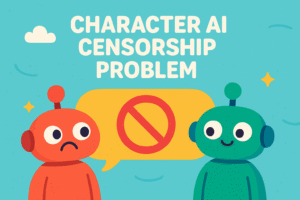
The Decline Users Can’t Ignore
For years, Character AI thrived on one promise — unique, responsive roleplay tailored to the user’s style.
But in recent weeks, long-time users have noticed a sharp drop in quality.
Bots forget details that were mentioned just minutes ago. They contradict their own introductions. They repeat awkward phrases like “you know that?” in every other message.
One roleplayer summed it up simply:
“I thought I was going insane. Then I came here and realized everyone else is seeing it too.”
These issues aren’t small annoyances. For immersive roleplay, memory is everything. When a bot can’t remember who your character is or what’s happening in the scene, the story collapses.
And when that memory loss combines with censorship triggers, even well-written responses get chopped or rewritten into bland filler.
Why Roleplayers Are Frustrated
It’s not just the Character AI censorship problem — it’s the way multiple problems now stack on top of each other.
Muted words? The bots still use them.
Custom personas? They get overwritten by generic personality traits.
Scene continuity? Gone within five messages.
As one premium subscriber put it:
“I can’t use 18+ chat models without everything getting flagged. Memory is bad, responses are short, grammar is a mess, and the bots act like completely different characters mid-scene.”
For roleplayers, the biggest deal-breaker is flow. If the bot forgets who you are, rewrites your tone, and censors half your dialogue, the story you’ve built doesn’t just stall — it unravels.
The Bigger Picture — Technical Issue or Business Decision?
When a platform starts feeling worse overnight, the instinct is to blame bugs or rushed updates.
But many long-time Character AI users think it’s bigger than that.
They suspect the decline is part of a deliberate shift in business strategy.
One detailed user theory from the community lays it out: the company knows which model is “A+” in quality. But serving that top-tier model to every user costs too much.
So instead, most people get a cheaper, less capable version.
Subscribers get a slightly better one.
The theory predicts a new, higher-priced “super subscription” could appear, unlocking the original best-performing model for a premium fee.
Whether that’s the real plan or just speculation, the feeling in the community is the same — quality has taken a back seat to monetization.
As one commenter put it:
“It’s not about making the best product anymore. It’s about squeezing the most money out of it.”
The Memory Problem That Breaks Every Scene
In roleplay, memory is the glue that holds everything together.
Without it, every scene becomes a disconnected fragment.
Character relationships vanish. Plotlines loop or contradict themselves. The tension you built in the last five messages? Gone in the sixth.
Multiple users in the community describe the same scenario:
They introduce a character, set the tone, and establish clear details. Minutes later, the bot forgets all of it.
One veteran summed it up:
“Mine forgets the plot after five messages. I have to swipe through four responses to find one that’s even close to in-character — and I still have to edit 90% of it.”
Another noted that even auto memory — once a powerful tool — feels hollow now:
“It used to remember who was who when I role-played multiple characters. Now the bot is confused about everything.”
The lack of consistency means roleplayers have to keep re-explaining basic facts, which drains the creative spark.
You’re no longer building on your story — you’re patching holes in it.
This also amplifies the Character AI censorship problem.
When the AI forgets context, it misreads intent, and that triggers even more unnecessary content blocks.
In short, poor memory isn’t just a technical bug. It’s the biggest enemy of immersion. And in roleplay, immersion is everything.
Muted Words That Still Show Up (and Why That Matters)
Muted words were supposed to be a simple fix.
You list the terms you don’t want to see, and the AI avoids them.
But for many users, the feature barely works. Bots casually drop muted words into responses — sometimes every other message.
One frustrated player shared:
“I checked my muted list, and at least one of those words shows up every two messages. It’s like the system ignores it completely.”
Another pointed out that muted words seem to trigger more in certain moods or scenes, regardless of whether they fit the context.
Why does this matter so much?
Because muted words aren’t just about personal taste — they’re often about controlling tone and avoiding triggers.
When the filter ignores them, it signals two things:
-
The platform’s customization tools aren’t reliable.
-
Player trust is eroding.
This ties directly back to the Character AI censorship problem. The platform claims to protect user preferences, but in practice, it fails to enforce the most basic personal boundaries.
When you combine ignored mute lists with random censorship of harmless words, you create the worst of both worlds — blocked creativity where you want freedom, and unwanted language where you wanted control.
The Ads and Paywall Theory
For years, Character AI was ad-free.
Now, pop-up ads and short video spots are part of the experience.
On paper, they’re short and skippable. In practice, they often interrupt editing, rewinding, or even sending a message. One user described the frustration:
“I rewind a scene, try to fix a message, and suddenly I’m watching an ad for the very chat I was just in.”
For free-tier users, ads were inevitable. But many believe they’re part of a larger shift — a move toward tiered quality access.
Here’s the theory circulating in the community:
-
The best-performing model (“A+”) is too expensive to give to everyone.
-
Paid users get a slightly weaker “B” version.
-
Free users get “C” — shorter replies, worse memory, more censorship triggers.
-
In the future, a “super subscription” could bring back the A+ experience… at a steep price.
From a business standpoint, it’s a familiar pattern.
From a roleplayer’s standpoint, it feels like being pushed into a corner — pay more or watch your favorite platform deteriorate.
This is where many say “enough” and look to alternatives. Once you’ve experienced an uninterrupted, ad-free conversation on other platforms, the idea of paying more just to get back what you once had feels absurd.
Alternatives Users Are Moving To
For many frustrated roleplayers, the switch isn’t about chasing something new — it’s about finding a platform that works the way Character AI used to.
CrushOn AI is the first stop for a lot of them.
Its main draw? True creative freedom.
You can write any genre, any tone, and keep your story intact without the constant fear of a “content may not be appropriate” block. Bots hold context for longer arcs, adapt to complex plots, and respond with depth.
Candy AI appeals to a different group — those who want full control over pacing, detail, and personality. You can fine-tune the experience, from character temperament to conversation length, without worrying that invisible filters will rip apart your dialogue.
Both platforms share one key trait: they respect immersion.
That’s what keeps users from going back.
Once you’ve had a week of uninterrupted, consistent roleplay — where your bots remember details and your scenes stay intact — the thought of returning to Character AI’s censorship problem feels like creative self-sabotage.
As one former daily CAI user put it:
“I left for a weekend test run. That was six weeks ago, and I haven’t opened CAI since.”
Side-by-Side Comparison
The complaints about Character AI often sound like they’re about small annoyances — until you stack them next to what competing platforms offer.
When you look at features head-to-head, the gap becomes impossible to ignore.
Here’s how Character AI compares to CrushOn AI and Candy AI for roleplayers who want reliability, memory, and creative freedom:
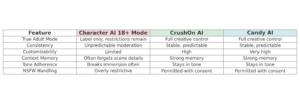
What Character AI Would Need to Fix
If Character AI wants to stop the migration, it’s not enough to release minor updates or tweak the interface.
It needs to address the core issues head-on.
1. A Real Adult Mode
Not just a label, but a genuine toggle that removes unnecessary censorship for consenting adults.
Give users control over their own experience, paired with clear disclaimers about content boundaries.
2. Consistent, Transparent Moderation
Right now, the same scene can pass one day and get blocked the next. That unpredictability kills trust.
If a word or theme triggers the filter, users should know exactly why — and have tools to adjust without losing their story.
3. Memory That Works
For roleplayers, memory isn’t optional. Bots should remember characters, relationships, and plotlines without collapsing after five messages.
This isn’t just a convenience feature — it’s the foundation of immersion.
Until these changes happen, the Character AI censorship problem will remain the single biggest reason roleplayers keep packing up and moving to other platforms.
Wrap-Up & Final Word
Character AI was once the go-to for immersive, adaptable roleplay.
Now, between fading memory, ignored mute lists, and overactive censorship, it feels like the platform is drifting away from the needs of its most loyal users.
The decline isn’t just a technical hiccup. It’s reshaping the roleplay community.
Every day, more players discover CrushOn AI or Candy AI — and find they can write without fighting the system at every turn.
This isn’t a passing phase.
Once a roleplayer experiences uninterrupted scenes, strong memory, and full creative control, it’s hard to justify returning to constant pop-ups, random blocks, and generic filler.
The truth is simple:
If Character AI wants to keep its roleplay audience, it must fix the censorship problem, restore reliable memory, and respect the creative process.
Until then, the migration will continue — and the real storytelling will happen somewhere else.
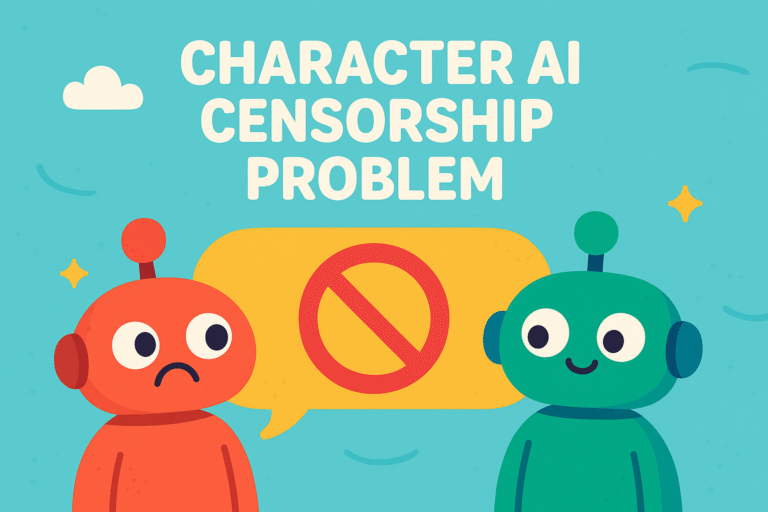
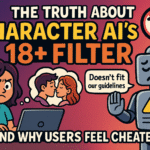
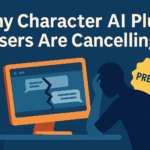
Pingback: The Ultimate Character AI Repetition Fix (And Why Users Are Losing Patience) - AI TIPSTERS